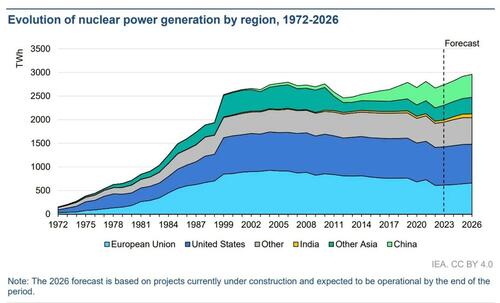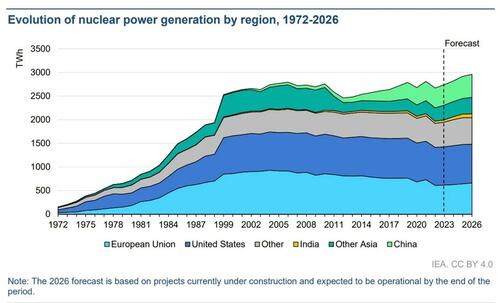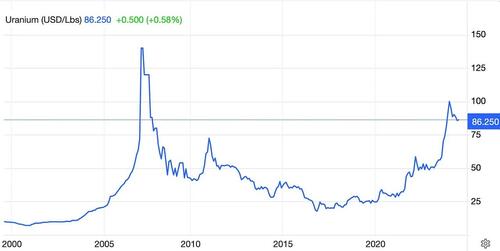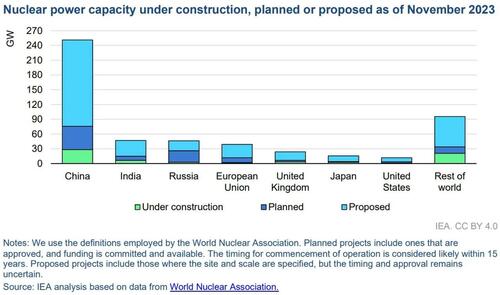
The New Gold Rush: Unlock Uranium’s Soaring Demand
Authored by Nomi Prins via Prinsights substack,
“Nothing exists except atoms and space, everything else is opinion.”
– Democritus, Ancient Greek Philosopher
Certain geopolitical events unleash unstoppable global re-alignments and national policy shifts.
Russia’s invasion of Ukraine in February 2022 was one of them.
The escalation of the Russia-Ukraine War made it clear to the U.S. that energy independence is critical for national and economic security. Nowhere is that more apparent than with nuclear energy. Russia supplies 35% of U.S. nuclear fuel. Kazakhstan supplies 25%.
Since 2022, legislators on both sides of the aisle, along with the White House and the Departments of Energy and Defense have accelerated discussions over nuclear energy and uranium supply chain policies.
Now, nuclear energy is familiar to the U.S. In fact, nearly 20% of U.S. electricity comes from nuclear power. Nuclear power also provides about 10% of the world’s electricity and 18% of electricity in OECD countries.
The truth is that no country, large or small, is looking for less energy. Electricity demand is increasing about twice as fast as overall energy use, and it will likely rise by 50% by 2040. Nuclear power capacity is forecast to grow in tandem.

Source: Carbon Credits
That’s why nuclear energy is an increasingly essential part of national defense and energy policy. Those who understand this resource will also be able to unleash its potential.
Let me explain…
Nuclear Energy Is (Back) in Vogue
Nuclear energy is the “Switzerland” of energy sources. It is increasingly popular with both sides of the political spectrum for several reasons.
First, nuclear energy is the most reliable baseload power source. That’s because it has the highest capacity factor, which measures how often a power plant runs at its maximum power.
Nuclear power can step in when other sustainable energy sources like wind and solar power can’t meet power needs.
Second, nuclear energy is nearly carbon-free, making it ideal to meet clean energy goals.
By increasing its nuclear energy use while also limiting its vulnerability to supply chains, the U.S. can lower its exposure to geopolitical tensions, price manipulations and foreign energy dependence.
The only way to achieve that is to secure domestic and reliable allied uranium supply sources and production. This would also require the development of more efficient technologies to refine uranium and convert it into nuclear energy.
Transformational U.S. Nuclear Energy Bills
After taking nearly two years to develop, several crucial bipartisan bills supporting nuclear energy, domestic and allied uranium supply, and technologies became law starting in late 2023.
The three you should know about are:
1. The Nuclear Fuel Security Act
This bill was signed into law as part of the National Defense Authorization Act (NDAA) on December 22, 2023. It establishes a strategic uranium reserve to ensure domestic uranium supply for national defense.
The Act creates new programs and expands existing ones to increase domestic supplies of certain types of low-enriched uranium (LEU) for nuclear energy, including high-assay low-enriched uranium (HALEU) used by advanced reactors.
2. The Accelerating Deployment of Versatile, Advanced Nuclear for Clean Energy (ADVANCE) Act
This Act passed the House on May 8, attached to S. 870, the „Fire Grants and Safety Act,” by a vote of 393-13. The Senate passed it by a vote of 88-2 on June 18. With votes like those, it should be clear that nuclear is popular across the aisle (a rarity in the D.C. Beltway).
The legislation invests in advanced nuclear technologies for efficient energy production. That includes the continued development of small modular reactors (SMRs) and microreactors.
The overwhelming bipartisan support for advancing nuclear energy as a clean and reliable power source will only serve to enhance energy independence and national security.
It was just signed into law on July 9th.
3. The Prohibiting Russian Uranium Imports Act
After Russia invaded Ukraine, escalating its war that started with its invasion of Crimea in 2014, the U.S. banned imports of certain Russian energy products like oil and coal. But it didn’t ban uranium due to a lack of domestic and allied supply.
In December 2023, the House passed H.R. 1042, the Prohibiting Russian Uranium Imports Act, by voice vote. Two months before that, I met with the senior staff of Rep. Cathy McMorris Rodgers (R-WA), who chairs the Energy and Commerce committee. She championed the bill. We discussed its importance for overall energy and national security.

Following productive meetings on Capitol Hill
The Senate passed its version by unanimous consent on April 30.
On May 13, the bill was signed into law.
The bill bans low-enriched uranium (LEU) produced in the Russian Federation or by a Russian entity, fuel used in domestic nuclear reactors.
It also allocates $2.72 billion to domestic and allied uranium companies to further advance domestic enrichment capabilities.
Uranium is More Powerful Than Gold
Those policy developments are boosting uranium prices and domestic uranium producer shares.
Uranium prices rose 3-fold since early 2020.
They more than doubled from July 2023 through January 2024 to $107 per pound before settling to current levels near $80-85 per pound, which are still up 60% since then.
That’s compared to gold at 19% and silver at 28% over that period.
Given the growing global need for uranium, I see uranium prices doubling over the next two years and surpassing the 2007 levels shown in the chart below.

Source: Trading Economics
Countries are now recognizing nuclear power’s energy potential, economic implications and clear national security benefits. Government investments and initiatives for uranium and nuclear energy companies include financial subsidies, tax incentives, grants and loan guarantees.
More than 20 countries at COP28, including the U.S., signed a declaration to triple nuclear power capacity by 2050. That would add 740 gigawatts (GW) of nuclear capacity to the existing stock of 370 GW. For reference, one gigawatt is equal to one billion watts. To put that into perspective, one gigawatt is enough to power an entire medium-sized city.
The World Nuclear Association reports that 68 GW of nuclear capacity is under construction. Another 109 GW is in the planning stages, and another 353 GW is proposed beyond that.
Plus, 29 GW of new capacity is expected to be in operation by 2026. China and India represent more than half of that. They will need more uranium to accomplish this.

Source: Carbon Credits
That means that the U.S. is in a race for uranium supply to fuel its own nuclear capacity growth, and the world is taking notice.
Several domestic miners have restarted operations across five states to meet growing demand and favorable policy. Those include IsoEnergy, Uranium Energy Corporation and Energy Fuels Inc.
Domestic U.S. and allied uranium producers, especially those with operating mines, will benefit in the coming months and years. So will nuclear energy technology companies.
You’ll be hearing much more from us on this mega-trend soon.
One way to take advantage of uranium and nuclear energy trends is to consider investing in the Global X Uranium ETF, URA. Many of the ETF’s top holdings are U.S.-based, or U.S allied uranium or nuclear technology companies.
* * *
Subscribe to Prinsights with Nomi Prins
Tyler Durden
Wed, 07/17/2024 – 19:30












